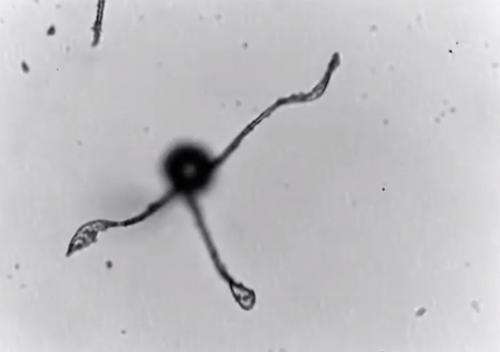September 11, 2013 report
Horsetail spores found able to 'walk' and 'jump' (w/ Video)

(Phys.org) —A trio of researches working at University Grenoble in France has discovered that spores produced by horsetail plants are able to move around using "legs" known as elaters. In their paper published in Proceedings of the Royal Society B, the researchers describe the types of movement exhibited by the spores when subjected to changing humidity conditions.
Prior to this new research, it was known that the spores produced by horsetail plants (their method of reproduction) moved some distance from the plant that created it. Some accounts even suggested that the spores walked along the ground after being released by the plant. Intrigued by such stories, the researchers with this new effort decided to take a closer look.
To find out what was really going on with the microscopic spores, the researchers put them under a microscope and filmed (using a high-speed camera) what they found. The spores, they saw, which have a central bulb surrounded by four independent elaters, are heavily impacted by the amount of moisture in the air. During times of high humidity, the elaters curl up, much like human hair—when the air dries out, so too do the elaters, allowing the curls to relax. It was this curling and relaxing that caused the spores to move in their environment—as the elaters unfurled against the ground, it caused the entire spore to move. More intriguingly, they found that on some occasions, the elaters uncurled so fast that it caused the entire spore to be pushed up into the air. Such jumps, the researchers noted, sometimes reached heights of centimeters—more than enough to allow the spore to leap into passing air currents, carrying them to a far flung locale.
The researchers also uncovered the mechanism behind the curling—the elaters are made of two different types of materials—one hard layer and one soft layer. The discrepancy between the ability of the two layers to absorb moisture causes the curling and uncurling.
Because of the simplicity of the mode of transport for the horsetail spore, the research team is now looking into ways that man-made objects might be made to move in the same ways. They envision self-spreading seeder devices or tiny probes that move themselves around crops testing for moisture or fertilizer levels.
More information: The walk and jump of Equisetum spores, Published 11 September 2013 DOI: 10.1098/rspb.2013.1465
Abstract
Equisetum plants (horsetails) reproduce by producing tiny spherical spores that are typically 50 µm in diameter. The spores have four elaters, which are flexible ribbon-like appendages that are initially wrapped around the main spore body and that deploy upon drying or fold back in humid air. If elaters are believed to help dispersal, the exact mechanism for spore motion remains unclear in the literature. In this manuscript, we present observations of the 'walks' and 'jumps' of Equisetum spores, which are novel types of spore locomotion mechanisms compared to the ones of other spores. Walks are driven by humidity cycles, each cycle inducing a small step in a random direction. The dispersal range from the walk is limited, but the walk provides key steps to either exit the sporangium or to reorient and refold. Jumps occur when the spores suddenly thrust themselves after being tightly folded. They result in a very efficient dispersal: even spores jumping from the ground can catch the wind again, whereas non-jumping spores stay on the ground. The understanding of these movements, which are solely driven by humidity variations, conveys biomimetic inspiration for a new class of self-propelled objects.
Journal information: Proceedings of the Royal Society B
© 2013 Phys.org
















